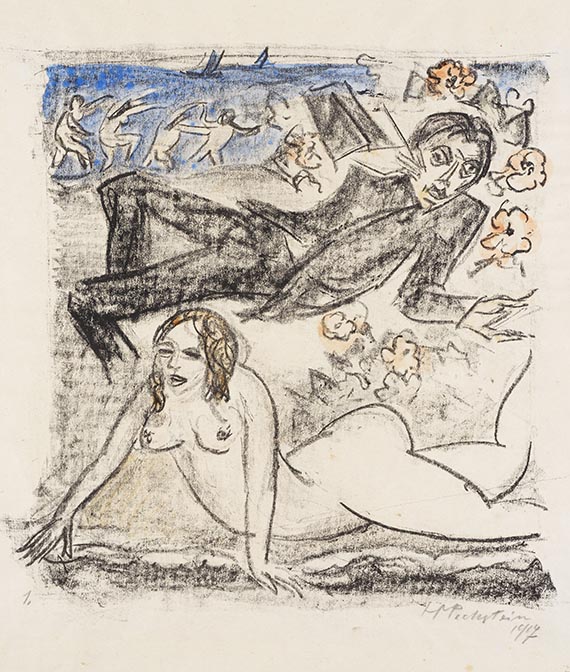78
Hermann Max Pechstein
Kleopatra und Dichter, 1917.
Lithograph
Starting bid: € 8,000 / $ 9,440
Kleopatra und Dichter. 1917.
Transfer Lithograph, with watercolor.
Signed, dated and inscribed "1." in the lower left. Trial proof with watercolor in addition to an edition of 130 copies. On bookprint paper . 33 x 32 cm (12.9 x 12.5 in). Sheet: 43,7 x 35 cm (16,92 x 13,72 in).
Final sheet in the portfolio "Heinrich Lautensack. Paraphrase zur Samländischen Ode". Published by Verlag Gurlitt, Berlin 1918. [MH].
•- Unique piece: colored trial print.
• Final sheet of Heinrich Lautensack's Paraphrasen zur Samländischen Ode.
• These illustrations count among the masterpieces of expressionist illustration art.
PROVENANCE: Private collection, Switzerland (since 1991, Pasquale Iannetti Art Galleries, San Francisco).
LITERATURE: Günter Krüger, Das druckgraphische Werk Max Pechsteins, Hamburg 1988, catalogue raisonné no. L 250.
In good condition, consistent with the age. Overall slightly wavy and slightly creased. The edges of the Sheet are slightly compressed in places. There is a crease mark in the upper left corner of the sheet, the upper left corner of the sheet is thinned. There are isolated brown spots and studio marks.
Transfer Lithograph, with watercolor.
Signed, dated and inscribed "1." in the lower left. Trial proof with watercolor in addition to an edition of 130 copies. On bookprint paper . 33 x 32 cm (12.9 x 12.5 in). Sheet: 43,7 x 35 cm (16,92 x 13,72 in).
Final sheet in the portfolio "Heinrich Lautensack. Paraphrase zur Samländischen Ode". Published by Verlag Gurlitt, Berlin 1918. [MH].
•- Unique piece: colored trial print.
• Final sheet of Heinrich Lautensack's Paraphrasen zur Samländischen Ode.
• These illustrations count among the masterpieces of expressionist illustration art.
PROVENANCE: Private collection, Switzerland (since 1991, Pasquale Iannetti Art Galleries, San Francisco).
LITERATURE: Günter Krüger, Das druckgraphische Werk Max Pechsteins, Hamburg 1988, catalogue raisonné no. L 250.
In good condition, consistent with the age. Overall slightly wavy and slightly creased. The edges of the Sheet are slightly compressed in places. There is a crease mark in the upper left corner of the sheet, the upper left corner of the sheet is thinned. There are isolated brown spots and studio marks.
78
Hermann Max Pechstein
Kleopatra und Dichter, 1917.
Lithograph
Starting bid: € 8,000 / $ 9,440
Headquarters
Joseph-Wild-Str. 18
81829 Munich
Phone: +49 89 55 244-0
Fax: +49 89 55 244-177
info@kettererkunst.de
Louisa von Saucken / Undine Schleifer
Holstenwall 5
20355 Hamburg
Phone: +49 40 37 49 61-0
Fax: +49 40 37 49 61-66
infohamburg@kettererkunst.de
Dr. Simone Wiechers / Nane Schlage
Fasanenstr. 70
10719 Berlin
Phone: +49 30 88 67 53-63
Fax: +49 30 88 67 56-43
infoberlin@kettererkunst.de
Cordula Lichtenberg
Gertrudenstraße 24-28
50667 Cologne
Phone: +49 221 510 908-15
infokoeln@kettererkunst.de
Hessen
Rhineland-Palatinate
Miriam Heß
Phone: +49 62 21 58 80-038
Fax: +49 62 21 58 80-595
infoheidelberg@kettererkunst.de
We will inform you in time.




 Lot 78
Lot 78 
